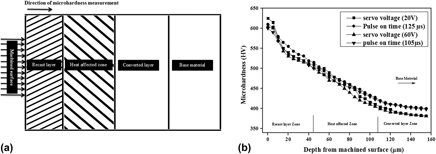Crossref Citations
This article has been cited by the following publications. This list is generated based on data provided by
Crossref.
Roy, Abhinaba
and
S, Narendranath
2018.
Impact of variation in wire electro discharge machining responses of homologous TiNiCu shape memory alloys for smart applications: an experimental investigation.
Materials Research Express,
Vol. 5,
Issue. 12,
p.
125701.
Soni, Hargovind
S, Narendranath
and
M R, Ramesh
2018.
Experimental Investigation on Effects of Wire Electro Discharge Machining of Ti50Ni45Co5 Shape Memory Alloys.
Silicon,
Vol. 10,
Issue. 6,
p.
2483.
Alqarni, Nawal D.
Wysocka, Joanna
El-Bagoury, Nader
Ryl, Jacek
Amin, Mohammed A.
and
Boukherroub, Rabah
2018.
Effect of cobalt addition on the corrosion behavior of near equiatomic NiTi shape memory alloy in normal saline solution: electrochemical and XPS studies.
RSC Advances,
Vol. 8,
Issue. 34,
p.
19289.
Shandilya, Pragya
Bisaria, Himanshu
and
Jain, P. K.
2018.
Parametric study on the recast layer during EDWC of a Ni-rich NiTi shape memory alloy.
Journal of Micromanufacturing,
Vol. 1,
Issue. 2,
p.
134.
Kadadevaru, Shubhang G
Kulkarni, Vinayak N
and
Gaitonde, V.N.
2019.
A Review on Surface Integrity Studies in Machining of Biomedical Alloys.
Materials Today: Proceedings,
Vol. 18,
Issue. ,
p.
5494.
Vignesh, M.
and
Ramanujam, R.
2019.
Machining of Ti–6Al–4V using diffusion annealed zinc-coated brass wire in WEDHT.
Journal of the Brazilian Society of Mechanical Sciences and Engineering,
Vol. 41,
Issue. 9,
Naresh, C.
Pant, Kavindra
Bose, P. S. C.
and
Rao, C. S. P.
2019.
Recent Advances in Material Sciences.
p.
409.
Bisaria, Himanshu
and
Shandilya, Pragya
2019.
The machining characteristics and surface integrity of Ni-rich NiTi shape memory alloy using wire electric discharge machining.
Proceedings of the Institution of Mechanical Engineers, Part C: Journal of Mechanical Engineering Science,
Vol. 233,
Issue. 3,
p.
1068.
Takale, Adik
and
Chougule, Nagesh
2019.
Optimization of process parameters of wire electro discharge machining for Ti49.4Ni50.6 shape memory alloys using the Taguchi technique.
International Journal of Structural Integrity,
Vol. 10,
Issue. 4,
p.
548.
Magabe, Raymond
Sharma, Neeraj
Gupta, Kapil
and
Paulo Davim, J
2019.
Modeling and optimization of Wire-EDM parameters for machining of Ni55.8Ti shape memory alloy using hybrid approach of Taguchi and NSGA-II.
The International Journal of Advanced Manufacturing Technology,
Vol. 102,
Issue. 5-8,
p.
1703.
Tahir, Waseem
and
Jahanzaib, Mirza
2019.
Multi-objective optimization of WEDM using cold treated brass wire for HSLA hardened steel.
Journal of the Brazilian Society of Mechanical Sciences and Engineering,
Vol. 41,
Issue. 11,
Jadam, Thrinadh
Sahu, Santosh Kumar
Datta, Saurav
and
Masanta, Manoj
2019.
EDM performance of Inconel 718 superalloy: application of multi-walled carbon nanotube (MWCNT) added dielectric media.
Journal of the Brazilian Society of Mechanical Sciences and Engineering,
Vol. 41,
Issue. 8,
Chaudhari, Rakesh
Vora, Jay J.
Mani Prabu, S. S.
Palani, I. A.
Patel, Vivek K.
Parikh, D. M.
and
de Lacalle, Luis Norberto López
2019.
Multi-Response Optimization of WEDM Process Parameters for Machining of Superelastic Nitinol Shape-Memory Alloy Using a Heat-Transfer Search Algorithm.
Materials,
Vol. 12,
Issue. 8,
p.
1277.
Soni, Hargovind
S., Narendranath
and
M. R., Ramesh
2019.
Effects of Wire Electro-Discharge Machining Process Parameters on the Machined Surface of Ti50Ni49Co1 Shape Memory Alloy.
Silicon,
Vol. 11,
Issue. 2,
p.
733.
Hargovind, Soni
Narendranath, Sannayellappa
and
Ramesh, Motagondanahalli Rangarasaiah
2019.
Advanced machining of TiNiCo shape memory alloys for biomedical applications.
Emerging Materials Research,
Vol. 8,
Issue. 1,
p.
14.
Sharma, Kaustab
Goyal, Ashish
and
Sharma, Ashok Kumar
2020.
Investigation of material removal rate on Ti-6Al-4V super alloy.
IOP Conference Series: Materials Science and Engineering,
Vol. 810,
Issue. 1,
p.
012045.
Soni, Hargovind
and
Mashinni, P M
2020.
Wire electro spark machining and characterization studies on Ti50Ni49Co1, Ti50Ni45Co5 and Ti50Ni40Co10 alloys.
Materials Research Express,
Vol. 7,
Issue. 1,
p.
016520.
Soni, Hargovind
Narendranath, S.
Ramesh, M. R.
and
Mashinini, P. M.
2020.
Enhanced process parameters using TOPSIS method during wire electro discharge machining of TiNiCo shape memory alloy.
Vol. 2205,
Issue. ,
p.
040005.
Chaudhari, Rakesh
Vora, Jay J.
Patel, Vivek
Lacalle, L. N. López de
and
Parikh, D. M.
2020.
Effect of WEDM Process Parameters on Surface Morphology of Nitinol Shape Memory Alloy.
Materials,
Vol. 13,
Issue. 21,
p.
4943.
Jadam, Thrinadh
Sahu, Santosh Kumar
Datta, Saurav
and
Masanta, Manoj
2020.
Powder-mixed electro-discharge machining performance of Inconel 718: effect of concentration of multi-walled carbon nanotube added to the dielectric media.
Sādhanā,
Vol. 45,
Issue. 1,




